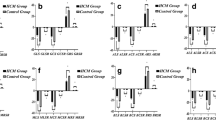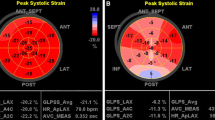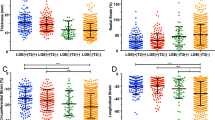Abstract
We used peak longitudinal strain (PLS) on TTE in HCM patients to differentiate LV myocardium (LVM) into the following 4 groups: group 1—no fibrosis or hypertrophy (≥ 13 mm), group 2—no fibrosis but hypertrophy evident, group 3—fibrosis present but without hypertrophy, and group 4—both fibrosis and hypertrophy. Seventeen HCM patients (13 males, 56 ± 16 years) underwent both 1.5 T CMR and TTE. On TTE, PLS (absolute values) for each LVM segment from 17 AHA-defined lesions was calculated. Of 289 LVM lesions, the numbers in each group, 1–4, were 156, 53, 39, and 41, respectively. PLS for LVM segments in group 1 (13.6 ± 6.4%) were significantly greater than those in group 2 (8.5 ± 4.9%, P < 0.001), group 3 (10.4 ± 5.0%, P = 0.006), and group 4 (7.1 ± 4.4%, P < 0.001). PLS for LVM segments in group 3 was significantly greater than those in group 4 (P = 0.016). However, significant differences in PLS in LVM between groups 2 and 3, and between 2 and 4 were not observed. Using regional PLS, we demonstrate successful differentiation of LVM in HCM patients for group 1 (LVM with zero fibrosis or hypertrophy) from LVM belonging to groups 2–4 and we also demonstrate successful differentiation of LVM with fibrosis present but without hypertrophy from LVM with both fibrosis and hypertrophy. However, it is not possible to differentiate between LVM with no fibrosis but hypertrophy evident and those with fibrosis present but without hypertrophy and also between LVM with no fibrosis but hypertrophy evident and those with both fibrosis and hypertrophy. Our findings have significant implications for the management of HCM patients.





Similar content being viewed by others
References
Okayama S, Soeda T, Kawakami R, Takami Y, Somekawa S, Ueda T, Sugawara Y, Matsumoto T, Sung JH, Nishida T, Uemura S, Saito Y (2015) Evaluation of coronary artery disease and cardiac morphology and function in patients with hypertrophic cardiomyopathy, using cardiac computed tomography. Heart Vessels 30:28–35
Chida A, Inai K, Sato H, Shimada E, Nishizawa T, Shimada M, Furutani M, Furutani Y, Kawamura Y, Sugimoto M, Ishihara J, Fujiwara M, Soga T, Kawana M, Fuji S, Tateno S, Kuraishi K, Kogaki S, Nishimura M, Ayusawa M, Ichida F, Yamazawa H, Matsuoka R, Nonoyama S, Nakanishi T (2017) Prognostic predictive value of gene mutations in Japanese patients with hypertrophic cardiomyopathy. Heart Vessels 32:700–707
Funada A, Kanzaki H, Noguchi T, Morita Y, Sugano Y, Ohara T, Hasegawa T, Hashimura H, Ishibashi-Ueda H, Kitakaze M, Yasuda S, Ogawa H, Anzai T (2016) Prognostic significance of late gadolinium enhancement quantification in cardiac magnetic resonance imaging of hypertrophic cardiomyopathy with systolic dysfunction. Heart Vessels 31:758–770
Reant P, Metras A, Detaille D, Reynaud A, Diolez P, Jaspard-Vinassa B, Roudaut R, Ouattara A, Barandon L, Dos Santos P, Lafitte S (2016) Impact of afterload increase on left ventricular myocardial deformation indices. J Am Soc Echocardiogr 29:1217–1228
Edwards NC, Moody WE, Yuan M, Hayer MK, Ferro CJ, Townend JN, Steeds RP (2015) Diffuse interstitial fibrosis and myocardial dysfunction in early chronic kidney disease. Am J Cardiol 115:1311–1317
Ishizu T, Seo Y, Kameda Y, Kawamura R, Kimura T, Shimojo N, Xu D, Murakoshi N, Aonuma K (2014) ventricular strain and transmural distribution of structural remodeling in hypertensive heart disease. Hypertension 63:500–506
Urbano-Moral JA, Rowin EJ, Maron MS, Crean A, Pandian NG (2014) Investigation of global and regional myocardial mechanics with 3-dimensional speckle tracking echocardiography and relations to hypertrophy and fibrosis in hypertrophic cardiomyopathy. Circ Cardiovasc Imaging 7:11–19
Cerqueira MD, Weissman NJ, Dilsizian V, Jacobs AK, Kaul S, Laskey WK, Pennell DJ, Rumberger JA, Ryan T, Verani MS, American Heart Association Writing Group on Myocardial Segmentation and Registration for Cardiac Imaging (2002) Standardized myocardial segmentation and nomenclature for tomographic imaging of the heart. A statement for healthcare professionals from the Cardiac Imaging Committee of the Council on Clinical Cardiology of the American Heart Association. Circulation 105:539–542
Ozawa K, Funabashi N, Sugiura A, Kobayashi Y (2016) Layer specific strain measurement and its relationship to heart failure indicators in systemic autoimmune disorder patients: a multi-layer transthoracic echocardiography study. Int J Cardiol 220:693–699
Nishi T, Funabashi N, Ozawa K, Takahara M, Fujimoto Y, Kamata T, Kobayashi Y (2016) Resting multilayer 2D speckle-tracking transthoracic echocardiography for the detection of clinically stable myocardial ischemic segments confirmed by invasive fractional flow reserve. Part 1: vessel-by-vessel analysis. Int J Cardiol 218:324–332
Sakuma H (2014) Late gadolinium enhancement and prognosis of hypertrophic cardiomyopathy. Circ J 78:832–834
Takaoka H, Funabashi N, Uehara M, Iida Y, Kobayashi Y (2017) Diagnostic accuracy of CT for the detection of left ventricular myocardial fibrosis in various myocardial diseases. Int J Cardiol 228:375–379
Valente AM, Lakdawala NK, Powell AJ, Evans SP, Cirino AL, Orav EJ, MacRae CA, Colan SD, Ho CY (2013) Comparison of echocardiographic and cardiac magnetic resonance imaging in hypertrophic cardiomyopathy sarcomere mutation carriers without left ventricular hypertrophy. Circ Cardiovasc Genet 6:230–237
Betancur J, Simon A, Halbert E, Tavard F, Carré F, Hernández A, Donal E, Schnell F, Garreau M (2016) Registration of dynamic multiview 2D ultrasound and late gadolinium enhanced images of the heart: application to hypertrophic cardiomyopathy characterization. Med Image Anal 28:13–21
Uematsu M (2015) Speckle tracking echocardiography–Quo Vadis? Circ J 79:735–741
Okada K, Kaga S, Mikami T, Masauzi N, Abe A, Nakabachi M, Yokoyama S, Nishino H, Ichikawa A, Nishida M, Murai D, Hayashi T, Shimizu C, Iwano H, Yamada S, Tsutsui H (2017) Characteristic systolic waveform of left ventricular longitudinal strain rate in patients with hypertrophic cardiomyopathy. Heart Vessels 32:591–599
Ozawa K, Funabashi N, Takaoka H, Kamata T, Kanaeda A, Saito M, Nomura F, Kobayashi Y (2015) Characteristic myocardial strain identified in hypertrophic cardiomyopathy subjects with preserved left ventricular ejection fraction using a novel multi-layer transthoracic echocardiography technique. Int J Cardiol 184:237–243
Ozawa K, Funabashi N, Tanabe N, Tatsumi K, Kobayashi Y (2016) Contribution of myocardial layers of right ventricular free wall to right ventricular function in pulmonary hypertension: analysis using multilayer longitudinal strain by two-dimensional speckle-tracking echocardiography. Int J Cardiol 215:457–462
Ozawa K, Funabashi N, Kamata T, Kobayashi Y (2017) Inter- and intraobserver consistency in LV myocardial strain measurement using a novel multi-layer technique in patients with severe aortic stenosis and preserved LV ejection fraction. Int J Cardiol 228:687–693
Ono R, Funabashi N, Ozawa K, Takaoka H, Kamata T, Kobayashi Y (2015) An educational intervention to help medical students achieve accurate and consistent measurement of longitudinal myocardial strain on transthoracic echocardiogram. Int J Cardiol 201:300–301
Ozawa K, Funabashi N, Kobayashi Y (2016) Left ventricular myocardial strain gradient using a novel multi-layer transthoracic echocardiography technique positively correlates with severity of aortic stenosis. Int J Cardiol 221:218–226
Takigiku K, Takeuchi M, Izumi C, Yuda S, Sakata K, Ohte N, Tanabe K, Nakatani S, JUSTICE Investigators (2012) Normal range of left ventricular 2-dimensional strain: Japanese Ultrasound Speckle Tracking of the Left Ventricle (JUSTICE) study. Circ J 76:2623–2632
Puntmann VO, Carr-White G, Jabbour A, Yu CY, Gebker R, Kelle S, Rolf A, Zitzmann S, Peker E, D’Angelo T, Pathan F, Elen Valbuena S, Hinojar R, Arendt C, Narula J, Herrmann E, Zeiher AM, Nagel E, International T1 Multicentre CMR Outcome Study (2018) Native T1 and ECV of noninfarcted myocardium and outcome in patients with coronary artery disease. J Am Coll Cardiol 71:766–778
Acknowledgements
This work is partially supported by a Grant from Japan Heart Foundation Research Grant (no Grant numbers). The authors of this manuscript have certified that they comply with the Principles of Ethical Publishing in the Heart and Vessels.
Author information
Authors and Affiliations
Corresponding author
Ethics declarations
Conflict of interest
There is no conflict of interest to declare.
Rights and permissions
About this article
Cite this article
Funabashi, N., Takaoka, H., Ozawa, K. et al. 2D speckle-tracking TTE-based quantitative classification of left ventricular myocardium in patients with hypertrophic cardiomyopathy by the presence or the absence of fibrosis and/or hypertrophy. Heart Vessels 33, 1046–1051 (2018). https://doi.org/10.1007/s00380-018-1155-z
Received:
Accepted:
Published:
Issue Date:
DOI: https://doi.org/10.1007/s00380-018-1155-z




